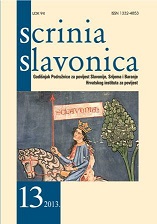Prikaz i analiza borbi na bosanskoposavskom bojištu 1992.
THE ANALYSIS OF THE MILITARY CONFLICT ON THE BOSNIAN-POSAVINA BATTLEFRONT IN 1992
Author(s): Mario Tomas, Ante NazorSubject(s): History
Published by: Hrvatski institut za povijest
Keywords: Homeland war; Republic of Croatia; Bosnia and Herzegovina; Bosnian Posavina; Army of Republika Srpska; Croatian Defence Council; Croatian Army
Summary/Abstract: The demise of the socialist system and the establishment of a multi-party system in 1990 allowed the articulation of national policies in Bosnia and Herzegovina. They created a set of opposing political concepts which fi nally led to the beginning of a con- fl ict started by the JNA and Serbian Democratic Party. On the basis of available documents, literature and scholarly publications, the author analyzes the course of waging the war on the Bosnian Posavina battlefront in 1992. During that year some of the largest battles in the course of the entire Homeland War - engaging more than 70,000 troops on both sides - occured in the strategically most important area of northern Bosnia and Herzegovina, the Bosnian Posavina region. These events are viewed within the context of combination of all the elements contributing to the situation on the battelfi eld. Some authors have argued that the Serb side owed their victory to a secret political agreement, disregarding the military aspect of the confl ict, but there is no direct evidence to support this theory. To abstract a war from the context in which it is fought and to study its course as a game means to ignore a dimension essential to the understanding not simply of the war itself, but of the societies which fought it. A complete and thorough analysis points to a more complex situation. The overwhelming superiority in manpower and in mechanized and armoured troops enabled to the Army of Republica Srpska to dictate fi ghting maneuvers in which the combined forces of the Croatian Army and Croatian Defence Council could not compete in a long term. This work aims not only at providing a military narrative, but also at analyzing the complex parallel processes that had an infl uence on the fi nal outcome of the confl ict.
Journal: Scrinia Slavonica
- Issue Year: 2013
- Issue No: 13
- Page Range: 277-315
- Page Count: 40
- Language: Croatian

